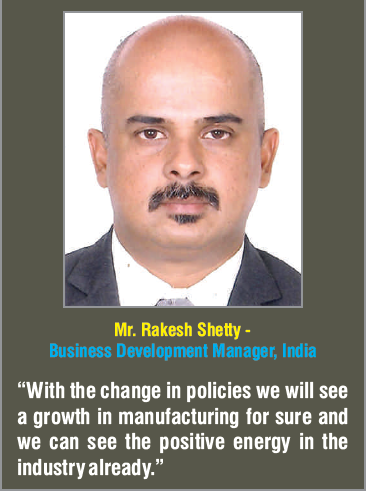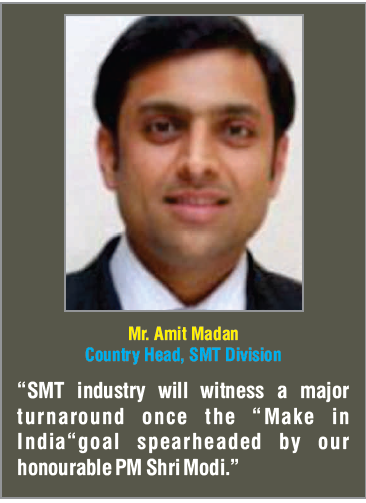PM Modi is talking about “Make in India – Electronics” and many prospective efforts are being made on this way. So when we manufacturer Equipments in India, their PCB will also manufacturer in India, so ultimately will Indian SMT industry is expected to get a boost as a indirect result of “Make in India” mission. To answer this question many established players associated with global manufacturers’ joined us. So here we go with an exclusive survey by EM Media…
 The need to raise the global competitiveness of the Indian manufacturing sector is imperative for the country’s long term-growth. Though the Modi Government’s Make-In-India push could possibly reduce electronic imports, the industry has reservations about the initiative. At the recently concluded India Electronic and Semiconductor Association (IESA) summit, the industry asserted that the country needs to cut down on its electronic imports.
The need to raise the global competitiveness of the Indian manufacturing sector is imperative for the country’s long term-growth. Though the Modi Government’s Make-In-India push could possibly reduce electronic imports, the industry has reservations about the initiative. At the recently concluded India Electronic and Semiconductor Association (IESA) summit, the industry asserted that the country needs to cut down on its electronic imports.
Make in India is the centerpiece of the Narendra Modi administration’s bid to revive manufacturing activities and create millions of jobs. With the Chinese economy slowing, India senses an opportunity in the industrial sector. In 2014-15, electronics system design and manufacturing (ESDM) market in India was estimated to be around $90 billion of which around 65-70 per cent of the demand was met through imports. “By 2016, we expect to bring it (exports) down to 50 per cent,” said Ashok Chandak, chairman of industry body India Electronics and Semiconductor Association (IESA). “This is an achievable goal.” Presently, there are around 250 companies working in the electronics system design and manufacturing (ESDM) in India almost 40 per cent of which are global companies. The sector employs around 2 million employees. The industry body expects that over the next five years, the sector would create around 27 million job opportunities and by that time the country is expected to be self-reliant in electronics goods demand.
Expected Electronic Market In India By 2020 :
• Telecom Equipment (USD 34 Billion).
• Laptops, Desktops, Tablets (USD 34 Billion).
• LED (USD 35 Billion).
• Consumer Electronics (USD 29 Billion).
• Set Top Boxes (USD 10 Billion).
• Automotive Electronics (USD 10 Billion).
• Medical Electronics (USD 8.5 Billion).
All the stated facts & figured signified the requirement of Make in India and supporting factors. Undoubting the policy with give Indian ESDM sectors a long term growth and a global recognition. Talking about another associate sector SMT, similar growth pattern is expected for SMT industry in India. Govt. is talking favorable steps by providing incentives and modified tax structure. Some of the favorable Govt. policies are:
- Modified Special Incentive Package Scheme (MSIPS) (USD 13.4 Billion investment proposals till March 2014).
- Electronics Manufacturing Clusters Scheme (EMC).
- Skill Development Scheme.
- Huge consumption in the Middle East and in emerging markets such as North Africa and Latin America.
- Existing R&D capabilities can be encouraged to develop ‘Made in India’ products and generate local IP.
The other influential factor on Indian industry is foreign investments. Recent visit of PM to Japan & Obama visit to India have open new foreign investments portals for India. Foreign companies will not only bring financials to the industry but also technology & global business opportunities to give Indian ESDM & SMT industry a stability & firm standing to Chinese competition. Some of the attracting factors to the investors have been:
- The Indian ESDM industry was estimated to be worth USD 68.31 Billion in 2012 and is anticipated to be worth USD 94.2 Billion by 2015 with a CAGR of 9.88% in 2011 – 15.
- The sector comprises Electronic Products, Electronic Components, Semiconductor Design and Electronics Manufacturing Services (EMS).
- Top 10 electronic products by total revenue: mobile phones, flat panel display TVs, notebooks, desktops, digital cameras, inverters / UPS, memory cards/USB drives, EMS/LCD monitors and servers.
Some of the favorable facts about India:
- India has the world’s largest single location forging facility
- 25% of the world’s new workers in the next 3 years will be Indians
- Indian Railways is the largest rail network in the world
- 9th largest economy in the world, 3rd largest by 2030
- Sustained GDP growth of over 8%
- 220 out of Fortune 500 companies outsource to India
- India has the 2nd largest pool of engineers and scientists
- India adds 1 “Netherland” mobile users/month, world’s 2nd largest mobile market
- India is the 7th nuclear power in the world India’s GDP/capita will multiply 4 times till 2020
 VI Technology Pvt. Ltd.
VI Technology Pvt. Ltd.
Mr. Rakesh Shetty – Business Development Manager, India
As per Mr. Shetty, Yes definitely, I think that we have been waiting for this tax relaxation so as to boost the electronics manufacturing in India. It’s good to know that the government has this on their priority list. With the change in policies we will see a growth in manufacturing for sure and we can see the positive energy in the industry already. Talking about 100% achievement of “Make in India Electronics Goal”, he said, yes why not, it is possible but we have a long way to go. With a population of over 1.2 billion people if we are able to produce even only for within our own capacity there is no looking back. The main challenge is our infrastructure which will determine the pace in which we will be able to increase the overall manufacturing growth. I have been working and seeing the SMT industry in India for over 20 years now and the progress so far has been slow. With the policy change we should see a growth in manufacturing for sure but may see a drastic growth suddenly. It will be still continue to grow in a steady pace and should gradually increase in the years to come. But we all know now is the time or never.
 Leaptech Corporation
Leaptech Corporation
Mr. Suresh Nair – Director
Mr. Nair commented on Government policies, yes, this will help SMT industry which was never taken seriously so far. On “Make In India electronics goal” yes India can achieve closer to 100% made in India goal provided all component manufacturing is done locally, currently most of the components and other inputs are being imported, these need to be made locally first in order to achieve higher overall local manufacturing.
Maxim SMT Technologies Pvt. Ltd.,
Mr. S. S Bist – General Manager
 The ‘Make in India’ campaign seems to have come at perfect time. Many giant foreign companies have already expressed their interest in setting up manufacturing facility in India. Aiming to make India as its export hub, some of the world manufacturer like Bosch, Samsung and Siemens today announced manufacturing in the country. But India can’t follow China in manufacture cheap goods in bulk at the cost of environment. We don’t want to go that route where there is no quality. Instead, India should chart its own path and focus on services, design and high-end manufacturing. Compliance with existing government complex laws is extremely difficult and this results in government officers harassing entrepreneurs. We should remove and simplify laws, and once simplified, make sure the laws are adhered to. First step is to keep the existing manufacturing facilities running. The starting point is to save the government units ITI’s, BEL and in private Nokia, foxcon at Chennai, these factories have the proven expertise in manufacturing.
The ‘Make in India’ campaign seems to have come at perfect time. Many giant foreign companies have already expressed their interest in setting up manufacturing facility in India. Aiming to make India as its export hub, some of the world manufacturer like Bosch, Samsung and Siemens today announced manufacturing in the country. But India can’t follow China in manufacture cheap goods in bulk at the cost of environment. We don’t want to go that route where there is no quality. Instead, India should chart its own path and focus on services, design and high-end manufacturing. Compliance with existing government complex laws is extremely difficult and this results in government officers harassing entrepreneurs. We should remove and simplify laws, and once simplified, make sure the laws are adhered to. First step is to keep the existing manufacturing facilities running. The starting point is to save the government units ITI’s, BEL and in private Nokia, foxcon at Chennai, these factories have the proven expertise in manufacturing.
 Innotronics Technologies Pvt. Ltd.
Innotronics Technologies Pvt. Ltd.
Mr. SP Arora – General Manager/Director Operations & Sales
As per Mr. Arora, there is nice initiative taken forward by Govt. of India, All these steps are favorable to grow and take forward domestic Electronics manufacturing industry to un-scaled height. Achieving 100% “Make in India” goal, will take long time for India to be able to say we do 100% make in India, till the time, we work on developing the resources like Semi conductor device & components, have foundries, develop eco system, leverage taxation nation wise, do way with lower customs duty on finished goods.
Juki India Pvt Ltd.
Mr. Praveen Madaan – Country Head
 In views of Mr. Madaan, government efforts are in right direction to promote local Manufacturing. This will definitely give positive signal to investors and many manufacturing units to come up in near future. Speaking about, if India achieve 100% “Made in India Electronics Goal” he said it is too early to say if India can achieve 100% Made in India Electronics Goal. There are many obstacles like Ease of doing business Funds availability and approval process from the banks Higher cost of Financing Lots of inefficiencies in the approval of projects and clearances. Cost of projects goes up by the time it is completed
In views of Mr. Madaan, government efforts are in right direction to promote local Manufacturing. This will definitely give positive signal to investors and many manufacturing units to come up in near future. Speaking about, if India achieve 100% “Made in India Electronics Goal” he said it is too early to say if India can achieve 100% Made in India Electronics Goal. There are many obstacles like Ease of doing business Funds availability and approval process from the banks Higher cost of Financing Lots of inefficiencies in the approval of projects and clearances. Cost of projects goes up by the time it is completed
- Lack of supporting industry for electronics manufacturing
- Lack of quality consciousness
- Cheaper and better quality products availability from China.
- Lower import duty on finished products and higher import duty on Capital Goods related to Electronics manufacturing.
Govt. need to work on high speed mode to clear polices and makes the procedures simple. We should be able to see the results of Govt. actions by end of 2015 if Govt. gives favorable budget in Q1.
 Trans-Technology Ind. Pvt Ltd
Trans-Technology Ind. Pvt Ltd
Mr. Amit Madan – Country Head, SMT Division
SMT industry will witness a major turnaround once the “Make in India“ goal spearheaded by our honourable PM Shri Modi, certain key challenges like nurturing skilled manpower across the country, enhancing the research & development in the field of electronics; pushing the envelope of local manufacturing in electronics by monitoring the issues of policies which cater to boost investments ,demand mindfulness from the government and authorities responsible for making India a manufacturing hub in near future.
Panasonic India Pvt Ltd.
Mr. Vishal Dahiya – Factory Automation (GM)
 As stated by Mr. Dhaiya, with all the initiatives by new Govt, the mood in electronics manufacturing industry is already very positive. This year we have already witnessed lot of investment in electronics manufacturing. I feel Govt is seriously moving towards creating a conduce environment for manufacturing. India Govt has taken many new initiatives to boost manufacturing in India and has come out with many business friendly policies. In fact various states Govt have also started competing with each other to attract electronic manufacturing. Simplification of tax structure & creation of supply chain will escalate this growth further. With the rise in local manufacturing the future of SMT industry looks very bright. The sectors which are creating immediate SMT demand are telecom, Automotive, LED & AV.
As stated by Mr. Dhaiya, with all the initiatives by new Govt, the mood in electronics manufacturing industry is already very positive. This year we have already witnessed lot of investment in electronics manufacturing. I feel Govt is seriously moving towards creating a conduce environment for manufacturing. India Govt has taken many new initiatives to boost manufacturing in India and has come out with many business friendly policies. In fact various states Govt have also started competing with each other to attract electronic manufacturing. Simplification of tax structure & creation of supply chain will escalate this growth further. With the rise in local manufacturing the future of SMT industry looks very bright. The sectors which are creating immediate SMT demand are telecom, Automotive, LED & AV.
Conclusion
Yes, Indian SMT industry is seeing good future with Make in India Campaign, but the challenges on the way will not be simple, industry, Govt, investors & public sector has to ca\one up at the same platform to bring this companion to the dreamed success.










